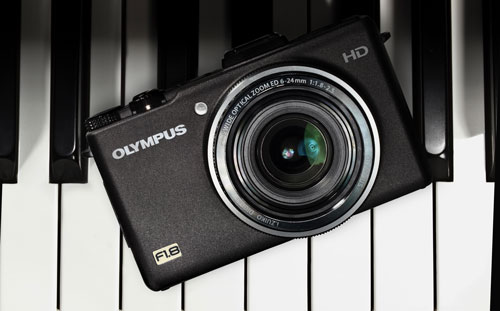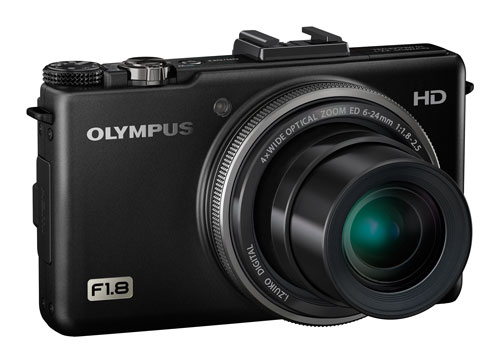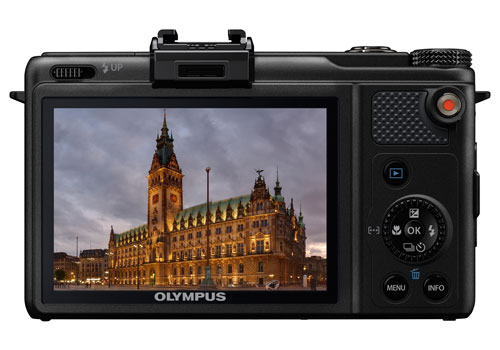
Japanese optics manufacturer Olympus has enjoyed mixed fortunes over the years. Today, it’s best known for its four-thirds, digital single-lens reflex (DSLR) system and its budget compacts. But with the XZ-1 the company is clearly hoping to reclaim a share of the high-end compact market from the likes of Canon’s S95/G series and Nikon’s P7100.
At the outset, the most notable feature of the XZ-1 is its fast aperture lens, something seldom seen in compact cameras. With a maximum aperture of f1.8, the XZ-1’s Zuiko lens – the first time a Zuiko lens has appeared in an Olympus compact — allows for a degree of control of depth of field that is usually restricted to DSLRs and makes it possible to shoot at lower ISO levels.
The lens also offers a useful zoom range, from the equivalent (in 35mm terms) of 28mm on the wide end, up to 112mm at the long end – or around 4x optical zoom in typical camera parlance.
Impressively, even at maximum zoom the aperture only stops down to f2.5, still respectably fast by any measure. Similarly impressive is the fact that it only stops down beyond f2.2 once it has passed the 100mm mark.
But a good lens is only as good as the sensor behind it, and here Olympus has outdone itself by including a 10-megapixel CCD sensor that’s one of the largest found in a fixed-lens compact today. Sensor size is important because it means better low-light/high-ISO performance and better colour rendition.
The XZ-1’s sensor is roughly three times the size of the sensors found in conventional compact digital cameras, and it’s also responsible for image stabilisation in the XZ-1. Interestingly, Olympus has also made it possible to record images as Raw or Jpeg files, or both.
As the name suggests, Raw is the unaltered data that the sensor gathers when an image is captured. Because it is entirely unprocessed, a Raw file is far larger than a format like Jpeg that necessarily loses data during compression.
But because it has more information than a compressed file, a Raw file allows for far greater leeway in terms of digital manipulation, hence its popularity with professional and serious amateur photographers.

It goes without saying that the XZ-1 has all of the standard features one would expect from an advanced compact camera. It’s some of the additions, though, that really make it stand out.
For example, it has a hot shoe that can accept a compatible flash unit, an external microphone for video recordings, an LED macro assistance light that Olympus released in conjunction with the XZ-1, or an electronic viewfinder (sold separately, of course).
A hot shoe on a compact is by no means unique, but the fact that it also supports wireless flash certainly is. What this means is that flash units can be triggered by means of a small burst from the XZ-1’s built-in flash — even some entry level DSLRs don’t offer that.
Another novel feature of the XZ-1, which seems at first like a gimmick but turns out to be rather handy, is the addition of a control dial around the lens itself, reminiscent of the aperture ring found on analogue-era SLR lenses.

The dial performs different functions in different modes: in aperture priority it adjusts the aperture, in shutter priority it adjusts the shutter, and in programme mode it adjusts ISO. It also encourages two-handed operation, which should result in greater stability and reduce the degree to which image stabilisation has to compensate.
The XZ-1 also offers a control wheel on top of the body for basic settings, and another that doubles as a four-way controller surrounding the OK button on the rear panel. The result is that once one is familiar with the camera’s controls they’re quick and easy to use.
We’ve never much cared for electronic viewfinders, particularly as they’re usually sold separately at exorbitant prices, and although the XZ-1 offers one in its list of optional accessories we can’t see why you’d want it when the camera itself has such a fantastic screen for composing shots and viewing them afterwards.

The 3-inch 601k dot OLED display offers great viewing angles, excellent colour rendition, and purportedly better battery life than a traditional LED display.
Another seemingly minor — but actually fantastic — feature of the XZ-1 is its dedicated video record/pause button on the top right of the rear panel. Not only does it allow one to record video immediately regardless of which mode the camera is in, it also means greater stability when starting or ending recordings. Like a dedicated camera button on a cellphone, it’s the sort of thing you don’t miss until it’s not there.
The only area where the XZ-1 doesn’t shine is video. It’s not that it’s bad — it shoots 720p HD video at 30fps, but it records video files as M-Jpegs, which is both an uncommon format and one that results in sizeable files. A nice move, however, is the inclusion of a stereo microphone that results in better sound than the mono microphones found in most compacts.
Also, it’s a pity that adjusting ISO and white balance generally requires digging around in menus, and that there is no dedicated AEL/AFL button which means you can’t meter/focus and then recompose a shot.
As digital photography has evolved, and compacts have begun to offer larger sensors with better low-light performance and increased functionality, they’ve been enjoying renewed popularity among enthusiasts and working photographers alike. The XZ-1 is likely to continue this trend.
The camera succeeds in combining functionality with portability, allowing for fine adjustments and complete manual control, alongside consumer-friendly features such as an automatic mode and artistic digital filters.
Craig Wilson takes a look at the Olympus XZ-1 (via YouTube):
The XZ-1’s lens makes it stand out in its class and when combined with the large CCD sensor, it produces excellent images. At R5 499, its price is in line with its competitors.
If you’re in the market for a high-end compact and portability is your main priority, the XZ-1 is a great choice. However, if you’re not concerned about size and are looking for a high degree of manual control, you’d still be better off buying a secondhand DSLR and kit lens. — Craig Wilson, TechCentral
- Subscribe to our free daily newsletter
- Follow us on Twitter or on Facebook

